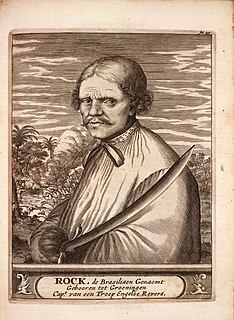
Buccaneers were a kind of privateers or free sailors peculiar to the Caribbean Sea during the 17th and 18th centuries. First established on northern Hispaniola as early as 1625, their heyday was from the Restoration in 1660 until about 1688, during a time when governments were not strong enough and did not consistently attempt to suppress them.

Sir Henry Morgan was a Welsh privateer, plantation owner, and, later, Lieutenant Governor of Jamaica. From his base in Port Royal, Jamaica, he raided settlements and shipping on the Spanish Main, becoming wealthy as he did so. With the prize money from the raids he purchased three large sugar plantations on the island.

Tortuga Island is a Caribbean island that forms part of Haiti, off the northwest coast of Hispaniola. It constitutes the commune of Île de la Tortue in the Port-de-Paix arrondissement of the Nord-Ouest department of Haiti.

Alexandre Olivier Exquemelin was a French, Dutch or Flemish writer best known as the author of one of the most important sourcebooks of 17th-century piracy, first published in Dutch as De Americaensche Zee-Roovers, in Amsterdam, by Jan ten Hoorn, in 1678.

Jean-David Nau, better known as François l'Olonnais, was a French pirate active in the Caribbean during the 1660s.

A pirate code, pirate articles or articles of agreement were a code of conduct for governing pirates. A group of sailors, on turning pirate, would draw up their own code or articles, which provided rules for discipline, division of stolen goods, and compensation for injured pirates.

Roche Braziliano was a Dutch pirate born in the town of Groningen. His pirate career lasted from 1654 until his disappearance around 1671. He was first made famous in Alexandre Exquemelin's 1678 book The Buccaneers of America; Exquemelin did not know Braziliano's real name, but historians have found he was probably born as Gerrit Gerritszoon and that he and his parents moved to Dutch-controlled Brazil. He is known as "Roche Braziliano", which in English translates to "Rock the Brazilian", due to his long exile in Brazil.

Laurens Cornelis Boudewijn de Graaf was a Dutch pirate, mercenary, and naval officer in the service of the French colony of Saint-Domingue during the late 17th and early 18th century.

The Black Corsair is an 1898 adventure novel written by Italian novelist Emilio Salgari. Set in the Caribbean during the Golden Age of Piracy, the novel narrates the exploits of Emilio Roccanera, Lord of Ventimiglia and his attempts to avenge his brothers, slain by the Duke Van Guld, now Governor of Maracaibo. The Lord of Ventimiglia, known throughout the Spanish Main as the Black Corsair, allies himself with some of the greatest pirates and buccaneers of the era: François L'Ollonais, Michael the Basque and Henry Morgan, vowing never to rest until he attains his vengeance.

Pierre Le Grand was a French buccaneer of the 17th century. He is known to history only from one source, Alexandre Exquemelin's Buccaneers of America, and may be imaginary.
Captain John Coxon, sometimes referred to as John Coxen, was a late-seventeenth-century buccaneer who terrorized the Spanish Main. Coxon was one of the most famous of the Brethren of the Coast, a loose consortium of pirates and privateers. Coxon lived during the Buccaneering Age of Piracy.

Edward Mansvelt or Mansfield was a 17th-century Dutch corsair and buccaneer who, at one time, was acknowledged as an informal chieftain of the "Brethren of the Coast". He was the first to organise large scale raids against Spanish settlements, tactics which would be utilised to attack Spanish strongholds by later buccaneers in future years, and held considerable influence in Tortuga and Port Royal. He was widely considered one of the finest buccaneers of his day and, following his death, his position was assumed by his protégé and vice-admiral, Henry Morgan.
Michiel Andrieszoon was a Dutch buccaneer who served as lieutenant to Captain Laurens de Graaf. He commanded the le Tigre, which had a 300-man crew and was armed with between 30-36 guns. He is occasionally referred to in English as Michel or Mitchell, and is often erroneously given the nickname "Bréha Michiel".
James Skyrme was a Welsh pirate best known for Captaining two of Bartholomew Roberts’ prize ships.
Francois Groginet was a French buccaneer and pirate active against the Pacific coast of Spanish Central America.
Jean L’Escuyer was a French pirate active on the Pacific coast of Central America. He sailed and fought alongside a number of prominent buccaneers such as Edward Davis, Francois Grogniet, William Dampier, and others.

Etienne de Montauban was a French flibustier (buccaneer), privateer, and pirate active in the Caribbean and off the west African coast. Frequently referred to as Sieur de Montauban, he wrote an account of his later voyages including surviving a shipwreck.

Alexandre Bras-de-Fer was a flibustier in the latter half of the mid-17th century. He is best known for capturing a Spanish ship after being shipwrecked, though his story is possibly apocryphal.

Michel le Basque was a pirate and flibustier from the Kingdom of Navarre in the southwest of France. He is best known as a companion of François L'Olonnais, with whom he sacked Maracaibo and Gibraltar.
















